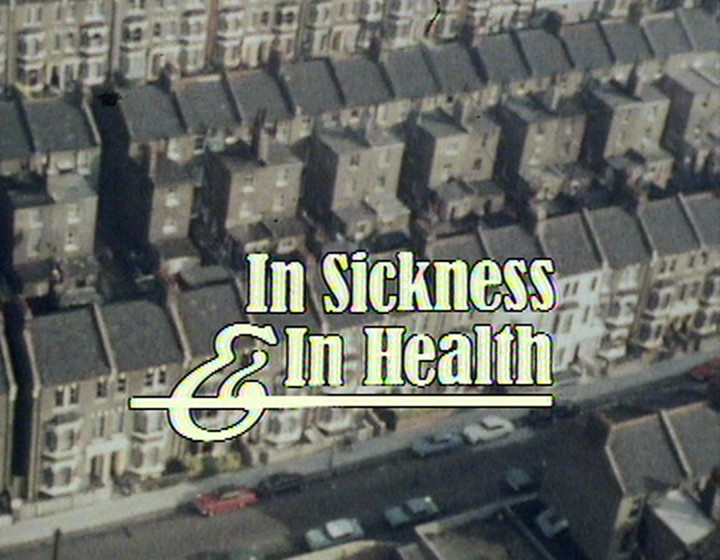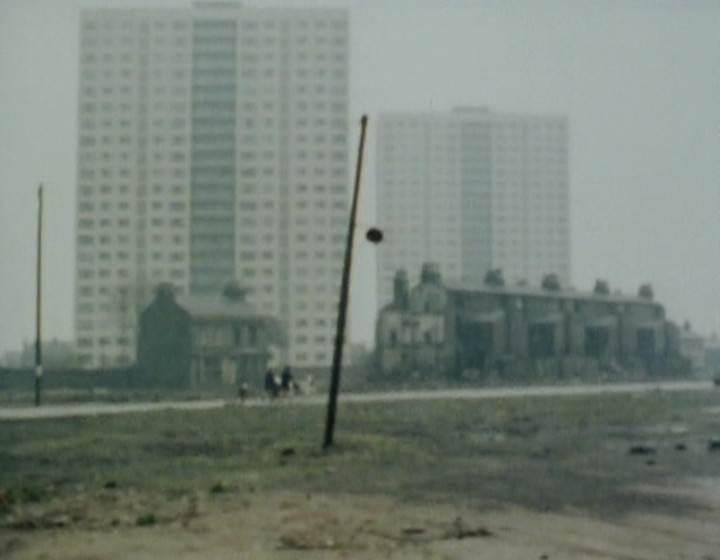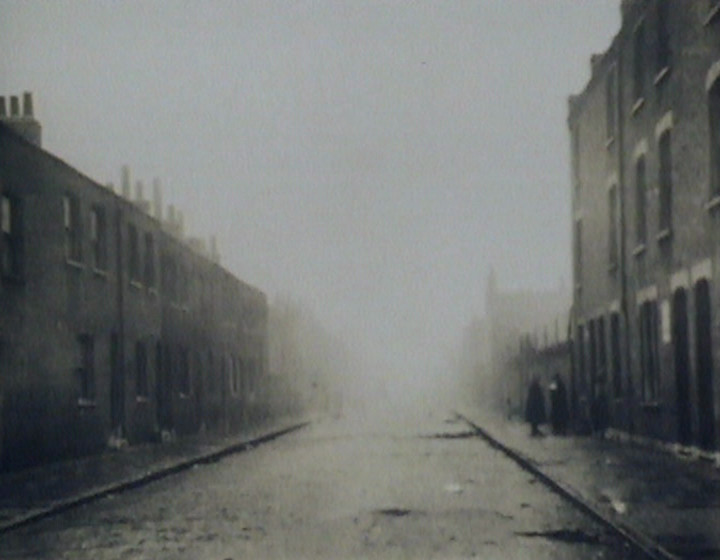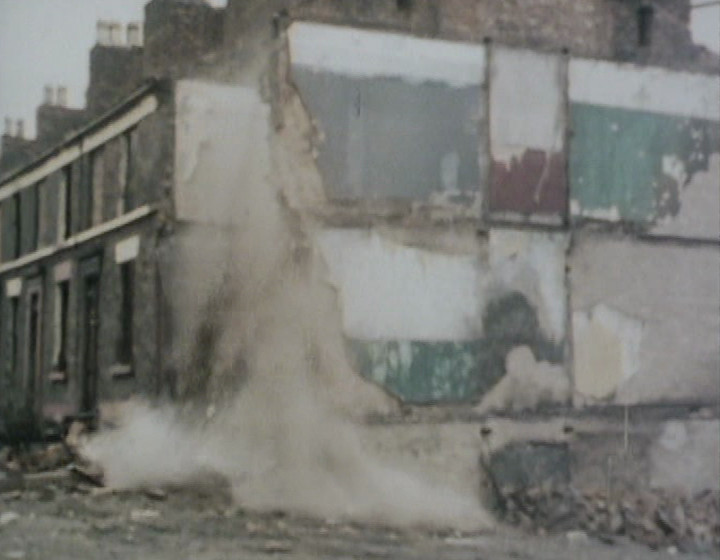Last time we took a look at In Sickness and in Health, I spent a long time fantasising about a certain evening at Television Centre. Surely it’s about time we tackled the actual programme, in terms of the kind of ideas Speight was trying to get across with the series?
Yeah, yeah, at some point. Today, I want to be mildly irritating about the title sequence instead. Specifically, the title sequence for the show’s very first series.
If we check the paperwork for the pilot, broadcast on 1st September 1985, we discover something rather interesting about it:
Opening Titles:
Total Dur: 0.38″Montage of shots of the East End
BBC Specially shot (16mm col) 9/16.3.85 (33″)
+ five stills from ‘HORIZON’ – “The Writing On The Wall” Orig. TX: 11.2.74 (5″)
Some of that title sequence was filmed specifically for the series, on the 9th and 16th March 1985. But other shots are stock footage, taken from an edition of Horizon broadcast over a decade earlier. Which sounds ripe for a Dirty Feed investigation, don’t you think?
* * *
The edition of Horizon in question, “The Writing on the Wall”, was first broadcast on BBC2 on the 11th February 1974. The Radio Times describes the programme as follows:
Could the crime and vandalism of New York ever occur in our cities? Professor Oscar Newman has shown in America how vandalism and bad housing design are related. One new housing project in St Louis is now being demolished after it became too dangerous to live in. Horizon brought NEWMAN to England to see if we are making the same mistakes in housing as architects have done in America.
Narrator PAUL VAUGHAN
Film editor SUE NEW Editor BRUCE NORMAN
Producer JOHN M. MANSFIELD
A slightly unusual topic for Horizon, which tended to focus more on pure science, but nothing too out of the ordinary. And yet this programme turned out to be surprisingly controversial. Luckily, unlike many 70s editions of the show, we can judge the programme for ourselves; it’s publicly available on YouTube. In terrible quality – for a start, the programme was originally in colour, not black and white – but it’s there.
Not only that, but it’s actually well worth watching for yourself, regardless of any connections with Alf Garnett. I found it fascinating.1
The focus of the programme is on the theory of “defensible space”, and is based around Newman’s first book about the subject, from 1972. In short, his theory2 contends that criminal behaviour is affected by the architecture of where people live, and that by designing housing correctly so that people have more ownership and investment in the surrounding public and semi-public spaces, crime can be vastly reduced. There is of course much more to the concept than this, but that’s the simple version.
Over the years, the programme has been criticised from numerous different standpoints. Firstly, we have the kind of objection exemplified by this piece by John Grindrod:
“This Horizon documentary ‘The Writing on the Wall’ featuring Newman was broadcast two years after the Pruitt-Igoe estate in St. Louis, Missouri was demolished. Pruitt-Igoe was the poster boy for urban decay and the failure of modernism, if that was the way you liked it. And that certainly was how Newman liked it. His critique of the public space embodied in so much of postwar planning and architecture would eventually lead to the situation we have today: a political distrust of council housing and modernist design, and a three decades long swing towards the privatisation of public space.”
I don’t disagree that Newman’s ideas may well have been taken and extended long past breaking point, but it’s worth pointing out that the Horizon documentary itself is far from a blanket critique of public space. Indeed, it is very invested in the idea that public space should exist, and be made better. One point the documentary specifically makes is that giving kids public space to play in, and then putting up a NO BALL GAMES sign, is ridiculous and self-defeating. A documentary which wasn’t interested in public space wouldn’t care about those signs in the first place.
Other critiques of the programme, I think, are more justified. Certainly, Newman’s portrayal of why the Pruitt–Igoe housing project in St. Louis failed feels at best rather simplistic, and doesn’t take into account the many other factors involved. In particular, the subject of race and racial inequality teeters at the edges of the documentary, without ever truly being tackled.
And then there’s Newman’s conclusion, delivered dramatically at the Aylesbury Estate. The best precis of the issues concering this which I could find is in the description for this 2013 event, featuring a showing of the programme:
“In this rare BBC documentary footage, Newman tours around the then recently completed Aylesbury Estate, critiquing the design of this Large Panel System-built housing, and suggesting a causal relationship between its environment, crime and social problems. The film was controversial at the time, with Building Design claiming that the Aylesbury had been ‘scarred forever’ by Newman’s ‘trial by TV’ and The Architect referring to his ‘hysterical patrol around the estate’.”
I think it’s clear that Newman makes a bad mistake with his summing up; a summing up which he clearly knows is overreaching, filled as it is with just a few too many qualifiers, and a whole buttload of waffle. For a programme which I would argue is more balanced than its reputation3, it’s an odd, forced misstep. Newman could have quite easily have expressed concern about the environment the kids on the estate were growing up in, and the effect it might have on them, without blatantly hinting that they may become the criminals of tomorrow.
Criminals are often damaged people; damaged people are not necessarily criminals.
* * *
Regardless of all this, let’s get back to In Sickness and in Health, and see if we can find our stock Horizon footage. And very quickly, we run into a problem. Because despite a careful watch of the entire documentary as embedded above, none of the images from the Sickness title sequence are present in the above video.
What the hell’s going on?
The answer quickly becomes obvious. If you take a look at the documentary above, it has a duration of 43’38”. But it originally had a 50 minute slot on BBC2. The only version online is clearly incomplete. This is evident right at the beginning of the video: it even starts off in the middle of a sentence. The actual duration of the material is 50:00 – yes, fifty minutes exactly – as I have been able to confirm by getting hold of a viewing copy elsewhere. A whole 6’22” is missing from the front of the programme.4
Unfortunately, I can’t upload this complete version of the programme online.5 But I have examined it carefully to see if we can find the answer to our mystery. And sure enough, of the five shots which were supposedly lifted and used in In Sickness and in Health, I managed to find four of them.
They are, in the order seen in Horizon itself:


These two shots are right next to each other in the documentary, and are used as an illustration of the change in housing architecture. The narrator intones: “In Britain, could the design of houses and streets ever induce a situation where you don’t go out at night for fear of being mugged? It sounds improbable. But we too, like America, have become a land of skyscraper blocks, whose graffiti protests against this new environment.”


These two shots are also right next to each other, and are used to portray the old London slums being knocked down. “This block rehoused people from rat-infested slums. With excellent intentions, whole neighbourhoods have been, and are being, destroyed, to make way for so-called improved housing.”
But that’s just four shots. Aren’t there supposed to be five? I’m not going to get too hung up on that. The paperwork promises “five stills” from Horizon. Well, the second and fourth pictures aren’t stills at all; they’re very clearly moving footage. If the paperwork can’t even be bothered to get that right, I have no confidence that it can count correctly, either.
* * *
Which leaves us with just one final thing to ponder. But it’s something we have to be careful about. There’s no point in criticising Newman for overreaching in his documentary, only to then make exactly the same mistake here. There’s surely a limit to the parallels you can draw between a 1974 documentary, and a 1985 sitcom, just because one uses some stock footage from the other.
And yet I believe there is a point to be made here. Because in many ways, the opening titles to Series 1 of In Sickness and in Health are a little peculiar. The two shots of the slums are surely a nod to the kind of house Alf was living in originally in Till Death Us Do Part, since destroyed. But there are also many shots of high-rise buildings, above and beyond those nicked from Horizon. We even get the camera tilting up them, in a rather pointed fashion. If you didn’t know the series and just watched the title sequence, you’d surely assume that Alf had moved into a high-rise flat.
But that is not the case. The Garnetts did move to a tower block at the end of the first Till Death film, and were living there during the second, The Alf Garnett Saga. But by the time of In Sickness and in Health, they’ve moved again, to a flat in West Ham. You must surely imagine that if In Sickness and in Health had happened in the late 70s, the tower block would still have been the location of choice for Speight.6 But by 1985, they really were no longer seen as the future of British housing.
And if nothing else, perhaps Oscar Newman would have approved of that. In the 1980s, Alf Garnett regained his little piece of defensible space. And used it to the very full.
I wonder if his neighbours found themselves gazing wistfully at those tower blocks after all.
With thanks to Milly Storrington.
Especially the section demonstrating a relatively early CCTV system, at 26:09. ↩
Which is his. ↩
For proof of this balance: note that the programme goes out of its way to point out that not all tower blocks are created equal. Yes, Newman and the programme are generally very critical of high-rise buildings, but I would argue they are not demonised. ↩
Including a real crime scene photo, right at the very beginning, showing a murdered convenience store owner, which is surely something the BBC would never broadcast so incidentally these days. And at the very least, the face would be cropped out or blurred. ↩
Complete, that is, aside from 1’22” of black – audio still present and correct – which is supposed to contain the footage of the Pruitt-Igoe development being destroyed. This section is present on the YouTube copy, but appears to be damaged more than the rest of the upload. Coincidence? Who knows. ↩
Let’s ignore the seaside-themed Till Death… from 1981. Yes, I’ve seen it recently. Yes, it has some interesting aspects. No, it absolutely is not a lost classic. The last episode is the best, mind. ↩

4 comments
Billy Smart on 5 May 2023 @ 9pm
Houses into tower blocks was something of a long-established trope for British television credits by 1985. Its one element in the tremendous, semiotically dense, ‘Whatever Happened To The Likely Lads?’ opening. But its also there (in a more immediately apparent way) in Clement & La Frenais’ ‘Thick As Thieves’ – https://www.youtube.com/watch?v=opEv8w2seEU
John J. Hoare on 6 May 2023 @ 1am
You’ve hit on something I was dancing around in my closing, and didn’t quite dare to say. So I’ll dare to say it now.
Were they just reaching for the easy cliche in that Series 1 opening, rather than actually thinking about what the series itself was doing? What was a fascinating piece of social commentary in the 70s, is really starting to feel a little irrelevant by 1985.
James C on 7 May 2023 @ 12am
Difficult to imagine the Trotter family living anywhere else than “half a mile in the sky in a LEGO set built by the council” as Del Boy puts it. Would Only Fools have worked if they lived in a bungalow instead of a tower block?
Doolz on 28 May 2023 @ 10pm
The very premise for Still Game many years later.
Comments on this post are now closed.